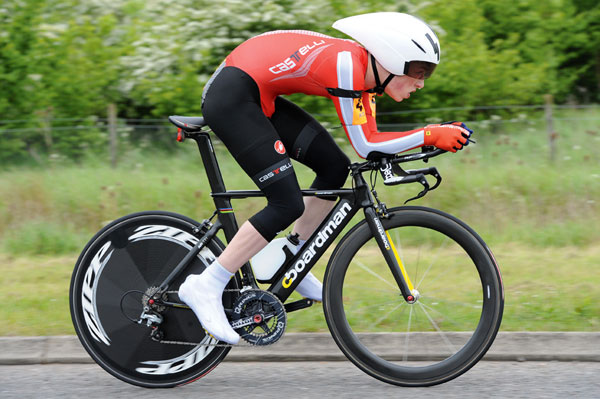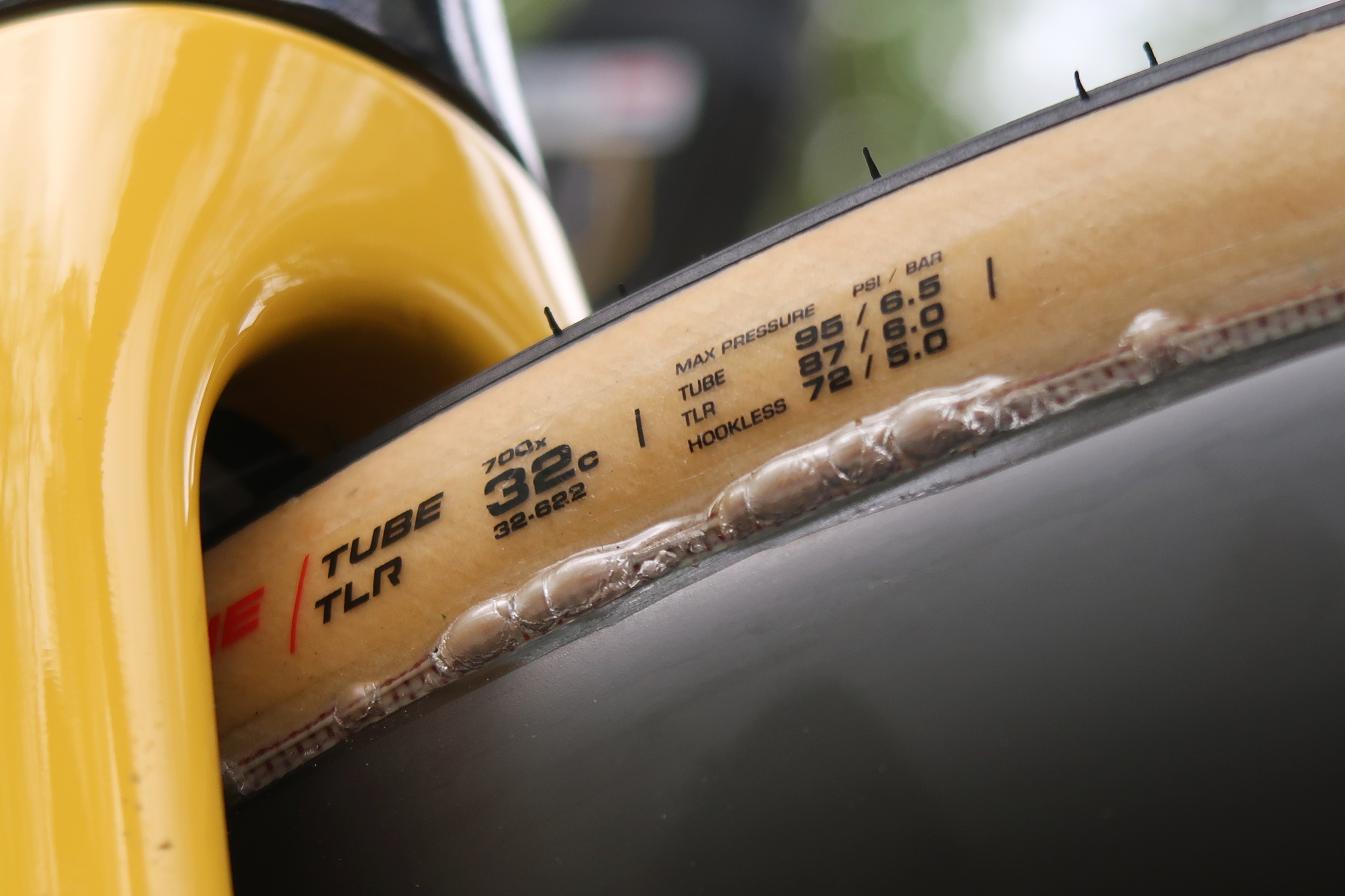Stay on the pace in a 25-mile time trial

2 weeks to prepare
The 25-mile time trial is all about pacing yourself. It's roughly speaking your ‘threshold' intensity - or the maximum amount of effort you can sustain for one hour.
This needs practising or you'll make the same mistake that most novice ‘testers' make (as well as many more experienced ones) of starting too fast, blowing up early in the ride and crawling to the finish line.
So with a couple of weeks to go practise sustaining the highest pace you can for around one hour a couple of times. Use a heart rate monitor to guide you if possible - check average heart rate over a one-hour test and if you finished too strong, try it again a few days later at a slightly higher rate.
If you finished the first test struggling, having blown up, try it again at a lower intensity. Remember that good TT pacing is all about constant effort at a level that just about allows you to make it over the line. On that last pedal stroke you should have nothing left in the tank.
Although for 25-mile TTs, anaerobic efforts at above threshold pace are less important, given the lack of time available in preparation for the event, shorter intervals spent at higher intensity might be advisable in order to develop the psychological courage of being able to sustain extended hard efforts.
Ensure as many of these preparation rides are completed in the drops, in as aero a position as possible.
Key goals:
- Identify the heart rate, power or practise the right effort ‘feel' to pace the event properly.
- Do your hard efforts in your time trial position.
4 weeks to prepare
Get The Leadout Newsletter
The latest race content, interviews, features, reviews and expert buying guides, direct to your inbox!
As mentioned above, ITT intensity is based on maintaining a high power output with a good aerodynamic position and four weeks allows you more time to develop both, but another consideration is energy availability and thermoregulation, which come into play the longer you are on the bike.
So practise techniques that minimise the time where you compromise your aerodynamic position while drinking, during your training rides. Also, one of the components of fitness specific to time trialling is flexibility in order to be able to maintain an aerodynamic position that is low at the front but keeping your eyes up for safety reasons and to target a good line.
Four weeks of flexibility and core strength work will make a significant difference to your performance on the day.
Key goals:
- Work on your core and flexibility to maintain your aero position.
- Keep focused on 20-minute time trial paced efforts.
6 weeks to prepare
With six weeks to prepare, you have enough time to increase your threshold pace by targeting event distance rides at around threshold intensity and shorter sessions at slightly higher pace as well as improving your aerodynamics.
Six weeks should also allow you sufficient time to fine tune the bike set-up to maximise the aero position and try it out, preferably on the actual course on which the event is to be held.
This also gives you the chance to practise correct lines through the bends and event-specific pacing strategy which might be dictated by hills or prevailing winds. Also, get into the habit of a structured warm-up before every event. This should raise heart rate to race-specific intensities but only in short durations so as not to compromise performance in the event itself.
Key goals:
- Refine your warm-up so you know exactly what you are going to do on race day.
- Make use of interval efforts that nudge your threshold up from below and pull it up from above.
High Intensity Interval Training
HIIT training has been seen to provide extremely impressive results in a very short time. The protocols dictate just a few minutes of maximal intensity intervals, interspersed with short recovery periods, completed just a few times per week and tests have shown some remarkable results in boosting both endurance and V02 max.
So with just weeks to go, no training in the bank, and little time to do any before your event, is HIIT the solution to all your problems?
The results are impressive, the training is very specific to road racing, and the boost to endurance is welcome. But be aware of the shortcomings. For sportives, for example, there is no replication of extended periods in the saddle, sustaining pace over several hours, riding uphill or developing group riding skills.
Further, any exercise regime that requires efforts of maximal intensity carries a high-risk element, extensive medical disclaimers, and require a lengthy integration period where you build up over several weeks, so would be unlikely to fit into a very short preparation schedule.
Target: 25-mile TT
Starting point: You're a regular rider but have done no specific TT training or preparation thus far.
| One | Flexibility and core strength | 30min@zone3A,15min@zone4,30min@zone3A,5min@zone2 | 10min @ zone 3A, 2 x 12min @ zone 4, 5min easy spin between each, 10min @ zone 2 | 20min core strength and flexibility routine | Rest day | Warm up 20min, 20min @ highest sustainable pace, 10min @ zone 2 | 60-90min @ zone 3A/ 3B |
| Two | Flexibility and core strength | 30min@zone3A, 30min@zone4, 30min@zone3A, 5min@zone2 | 10min @ zone 3A, 3 x 10min @ zone 4, 3min easy spin between each, 10min @ zone 2 | 20min core strength and flexibility routine | Rest day | Warm up 20min, 30min @ highest sustainable pace, 10min @ zone 2 | 60-90min @ zone 3A/ 3B |
| Three | Flexibility and core strength | 30min@zone3A, 40min@zone4, 30min@zone3A, 5min@zone2 | 10min @ zone 3A, 3 x 12min @ zone 4, 4min easy spin between each, 10min @ zone 2 | 20min core strength and flexibility routine | Rest day | Warm up 30min, 20 min @ highest sustainable pace, 10min @ zone 2 | 60-90min @ zone 3A/ 3B Use this ride practise cornerig |
| Four | Flexibility and core strength | 10min@zone3A,10min@zone4,10min@zone 3A,5min@zone2 | 10min @ zone 3A, 3 x 5min @ zone 4, 2min easy spin between each, 10min @ zone 2 | 20min core strength and flexibility routine | Rest day | Warm up 10min, 10min @ highest sustainable pace, 5min @ zone 2 | 40min @ zone 3A/ 3B, practise cornering in the drops |
| Five | Flexibility and core strength | 30min@zone3A, 30min@zone4, 30min@zone3A, 5min@zone2 | 10min @ zone 3A, 4 x 5min @ zone 5, 2min easy spin between each, 10min @ zone 2 | 20min core strength and flexibility routine | Rest day | Warm up 30min, 50min @ highest sustainable pace, 10min @ zone 2 | 60-90min @ zone 3A/3B Do this ride on the event course |
| Six | Flexibility and core strength | 30min@zone3A,30min@zone4, 30min@zone3A, 5min@zone2 | 10min @ zone 3A, 4 x 6min @ zone 5, 2min easy spin between each, 10min @ zone 2 | 20min core strength and flexibility routine | Rest day | Warm up 30min, ride 60min @ highest sustainable pace, 10min @ zone 2, ride on the event course in full TT set-up | 60-90min @ zone 3A/3B |
This article was first published in the May 30 issue of Cycling Weekly. Read Cycling Weekly magazine on the day of release where ever you are in the world International digital edition, UK digital edition. And if you like us, rate us!

Thank you for reading 20 articles this month* Join now for unlimited access
Enjoy your first month for just £1 / $1 / €1
*Read 5 free articles per month without a subscription

Join now for unlimited access
Try first month for just £1 / $1 / €1
Founded in 1891, Cycling Weekly and its team of expert journalists brings cyclists in-depth reviews, extensive coverage of both professional and domestic racing, as well as fitness advice and 'brew a cuppa and put your feet up' features. Cycling Weekly serves its audience across a range of platforms, from good old-fashioned print to online journalism, and video.
-
 Cycling's riders need more protection from mindless 'fans' at races to avoid another Mathieu van der Poel Paris-Roubaix bottle incident
Cycling's riders need more protection from mindless 'fans' at races to avoid another Mathieu van der Poel Paris-Roubaix bottle incidentCycling's authorities must do everything within their power to prevent spectators from assaulting riders
By Tom Thewlis Published
-
 Why Paris-Roubaix 2025 is proof that road bike tyres still have a long way to go
Why Paris-Roubaix 2025 is proof that road bike tyres still have a long way to goParis-Roubaix bike tech could have wide implications for the many - here's why
By Joe Baker Published